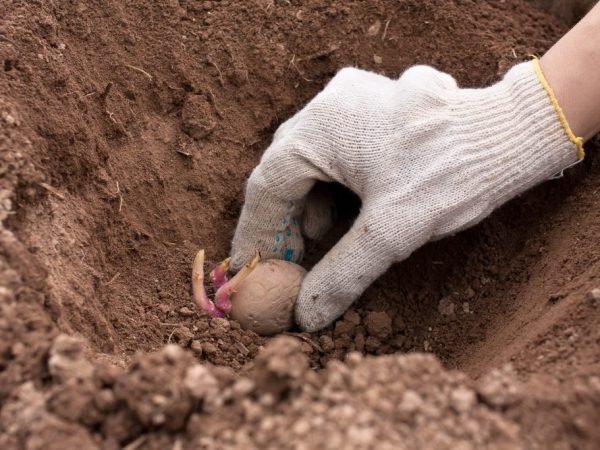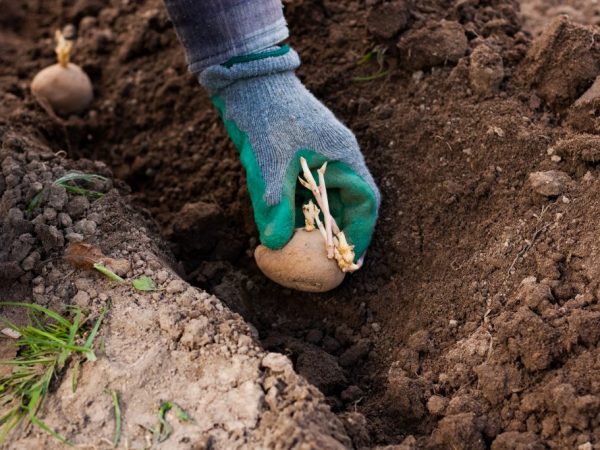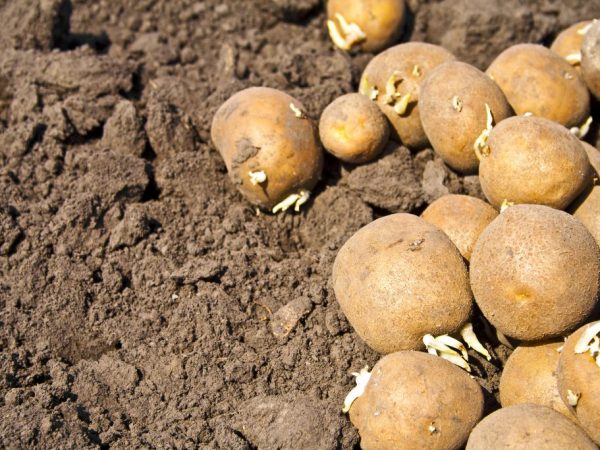Potato planting rules in 2019
A vegetable crop of the nightshade family is suitable for growing in all regions of the country. When choosing a planting day, it is recommended to study weather forecasts, a description of the selected variety. Planting potatoes in 2019 will give a good harvest in the future if carried out according to the lunar calendar.

Potato planting rules in 2019
Factors influencing the planting time
Choosing a day to plant potatoes is not an easy task. Climatic conditions differ in different regions of the country, therefore, the beginning of garden work varies. Dates are calculated depending on the season chosen for planting and the type of plant.
Potatoes are planted in various ways that affect the start time of this procedure:
- with the help of seedlings. Seedlings need at least 3 months to mature before being transferred. Sowing is carried out in the first decade of March, and planting in open ground - in June;
- in the greenhouse. Start from the desired harvest time. Young potatoes are planted in mid-February, and the harvest is in May;
- under the straw. Carried out when the temperature is stabilized at around 8 ° C;
- in the open field. Planting time depends on a combination of factors such as temperature, region and variety.
Lunar calendar
Having decided on the variety, knowing the features of the climate and the landing site, you can refer to the lunar calendar for 2019, which will help you choose the most favorable time for planting. It is recommended to plant tubers for human consumption after the new moon, and for seeds - before the new moon.
Sowing potatoes in 2019, according to the lunar calendar, is worth these days:
- January - 27-29 (seeds);
- March - 10-12, 21-25, 27-30;
- April - 2-5, 24-26, 28-30;
- May - 1-4, 10-12, 13, 14, 27-31;
- June - 1-2, 18-24, 26-30.
Unfavorable days:
- April - 20, 22-23, 27;
- May - 5-6, 19, 26;
- June - 3, 10, 17, 25.
Depending on the variety
The planting of early maturing varieties occurs in April, if the temperature is set at around 12-15 ° C. The first harvest ripens by the middle of the first summer month. Potatoes with an average ripening period (3-3.5 months) are usually planted in the second decade of May.
Late varieties of tuberous plants are used in cattle breeding as feed. They ripen before winter and require at least 4 months to grow. The optimal planting time is the second half of May or early June.
Depending on the region
In central Russia and the Leningrad region, it is recommended to plan planting work for May. The Moscow region starts half a month earlier and ends in May. Dates may vary due to weather conditions.
In the Urals, the planting time begins in the last decade of May, but it is better to postpone it until June. Sowing potatoes in the Kuban is allowed since March, which allows you to get more than one crop per season.
Basic rules for growing

Tubers must be processed before planting
Activities for preparing potatoes for planting begin in the fall. In the process of harvesting, the tubers are sorted out, carefully inspected, cleaned of dirt and sent to dry under a canopy. It is worth selecting material of medium size, with a mass not exceeding 100 g. Sorted vegetables are placed in nets or boxes (wooden) and placed in storage.
The timing of spring planting is determined individually for a specific region of Russia. Taking into account the peculiarities of the climate, planting potatoes in open ground begins in early spring and ends in June. At the same time, the planting material requires preliminary preparation, which will increase productivity and protect it from pests.
Preparation of planting material
They begin to study favorable days in winter, and the tubers themselves are taken out 1.5 months before the planting date. The "overwintered" planting material undergoes preliminary processing, which increases its vegetation qualities.
The tubers are removed from the cellar and warmed for 3-5 days at room temperature (23-25 ° C). The selected location should be well lit, but not in direct sunlight. First, the early ones are taken out and heated, then the middle ones, and then the late varieties.
Disinfection
Disinfection is a prerequisite to protect potatoes from pathogens. Enrichment of solutions with micronutrients is allowed, which will stimulate tubers to abundant fruiting. They are sprayed onto unhatched tubers.
A mixture of boric acid (15 g) with a solution of potassium permanganate (0.25 g per 5 L of water) and copper sulfate (5 g) is actively used. In addition, a folk remedy is used: 1 kg of ground garlic is diluted in 10 liters of water.
Potatoes with formed eyes are soaked in nutrient solutions 2-3 days before the date of disembarkation. They will help speed up the growing process and form healthy, dense tubers. In a thoroughly mixed solution (water - 10 l, nitrogen, phosphorus, potassium additives - 40 g), the germinated material is dipped.
Vernalization
Tuber planting season covers February, March, April. The procedure is carried out 1.5 months before the planned date of the work. They are laid out in a lighted place at a temperature not exceeding 15 ° C, and turned over every 5-7 days.
The lighting should be sufficient to form dense, thick, dark green sprouts with a purple tint. Lack of ultraviolet light will lead to thinning, brittleness and pale color of the shoots. The crop yield directly depends on the quality of the sprouts.
Notching technique
The potatoes are lightly pruned to stimulate the growth and development of the vegetable. The procedure helps to increase fruiting by 12-15%, subject to its completion 1.5-2 months before the day of planting.
There are 2 types of sections that activate different processes:
- horizontal. The strip runs along the width of the tuber, the connecting part between the two halves does not exceed 1 cm. The procedure activates the eyes, which are hidden and do not awaken during the greening process;
- diametrical. The section is laid along the entire circumference, causing the active growth of the bushy part of the potato. The depth of the cut should not exceed 1 cm.
Soil preparation

Choose a bright area for planting
The tuber is loyal to the composition of the soil. It is capable of producing crops in acidic soil, but it is worth maintaining the acid-base balance, which should not exceed the mark 5. Lime, which is applied as fertilizer, helps to reduce the acidity of the soil. Planting potatoes brings a high yield on fertile soils rich in black soil.
The vegetable culture is demanding on lighting, so the site is chosen without shading. It is worth checking the depth of groundwater: it must exceed 0.5 m. Erosion of the soil will lead to rotting of tubers, reduction or complete destruction of the crop.
The direction of the beds from north to south is considered optimal.Planting potatoes will be successful in the ground where radishes, radishes, beans, cabbage, carrots and beets were previously sown.
The preparation of the site begins in the fall, after the previous harvest has been collected. Loosening of the soil (but not leveling), fertilization is encouraged. With the beginning of the planting season (March, April), the garden is plowed again, if necessary, sand is added.
Planting rules
Planting works are carried out with the beginning of the spring thaws, when the temperature of the open ground reaches the optimal level. The exception is sowing seeds, which is carried out at home in January. The southern regions start gardening at 6-8 ° C, and the northern and central regions at 10-12 ° C.
It is recommended to plant potatoes according to a special algorithm:
- prepare the ground for the formation of rows. On the selected day, stones are removed from the site, lumps are broken with a rake and the bed is leveled. The minimum distance between rows is 60-70 cm;
- holes are dug in the formed rows with a depth of at least 12 cm.At the same time, a distance between the seedlings of 30 cm is observed;
- the bottom of the hole is covered with organic fertilizer: humus, wood ash or compost. 2 green tubers are laid in it and covered with earth.
Care
New plantings require careful maintenance, which begins before emergence. Regardless of the variety, tubers need air circulation, so you need to loosen the soil regularly.
The procedure after watering is especially relevant: it prevents the topsoil from hardening. Freshly planted tubers will not be able to hatch through the hard rind.
During the appearance of buds, the plants are watered systematically, preventing the soil from drying out more than 6-8 cm in depth. The procedure is carried out at sunset so that the sun's rays do not burn the leaves. The next morning, loosening and hilling are performed (with the exception of the southern regions).
In May-June, with the arrival of intense heat, the bush requires 3-4 liters of water.
Pest control
The beds with hatched potatoes should be protected from the attack of the Colorado potato beetle and wireworm. They are capable of damaging leaves and inflorescences, which will reduce the quantity and quality of the crop.
The terms of preventive maintenance are set taking into account the region and its climatic characteristics. The onion husk, which is buried in the hole when planting, is capable of preventing the appearance of the beetle. It also helps "dusting" the bushes with sifted wood ash. Green manure crops (mustard and peas) will help to cope with the wireworm.
The timing of digging up potatoes
They refer to the lunar calendar not only when planting, but also when harvesting. The period of the waning moon becomes optimal for extracting tubers from the ground. The vegetation process slows down, the fruits retain all the flavor characteristics. Since when does the harvesting of tubers take place, depending on the variety:
- early - from July;
- middle and late - from August to September.
The days favorable for digging potatoes in 2019 are 2-3, 31 August and 1, 29-30 September. It is not recommended to carry out any procedures during the full moon, new moon and eclipse. Unfavorable days of the last month of summer 2019 are considered to be the 1st and 30th, and in September - 28th.



